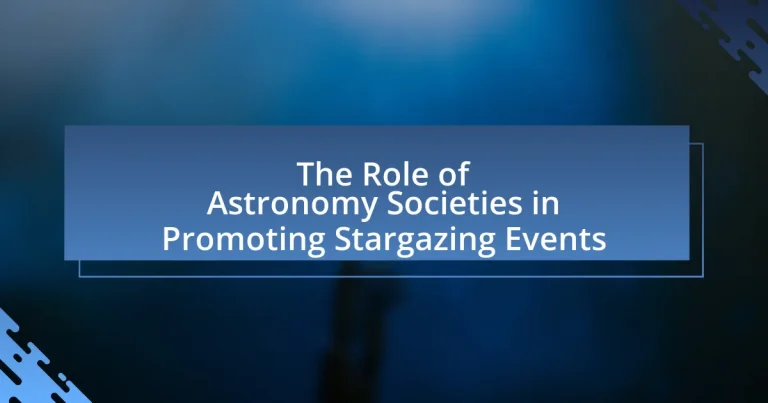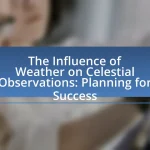Astronomy societies play a vital role in promoting stargazing events through public outreach programs that enhance community engagement with astronomy. They organize various activities such as star parties, workshops, and lectures, which provide opportunities for individuals to learn about celestial phenomena and observe the night sky. These societies collaborate with schools and local organizations to increase public interest in astronomy, utilizing social media and local advertising to reach diverse audiences. Additionally, they face challenges such as light pollution and weather conditions, but implement strategies to overcome these obstacles and foster a sense of community among participants. The article explores the significance of these initiatives, their impact on local stargazing participation, and the educational benefits they provide.
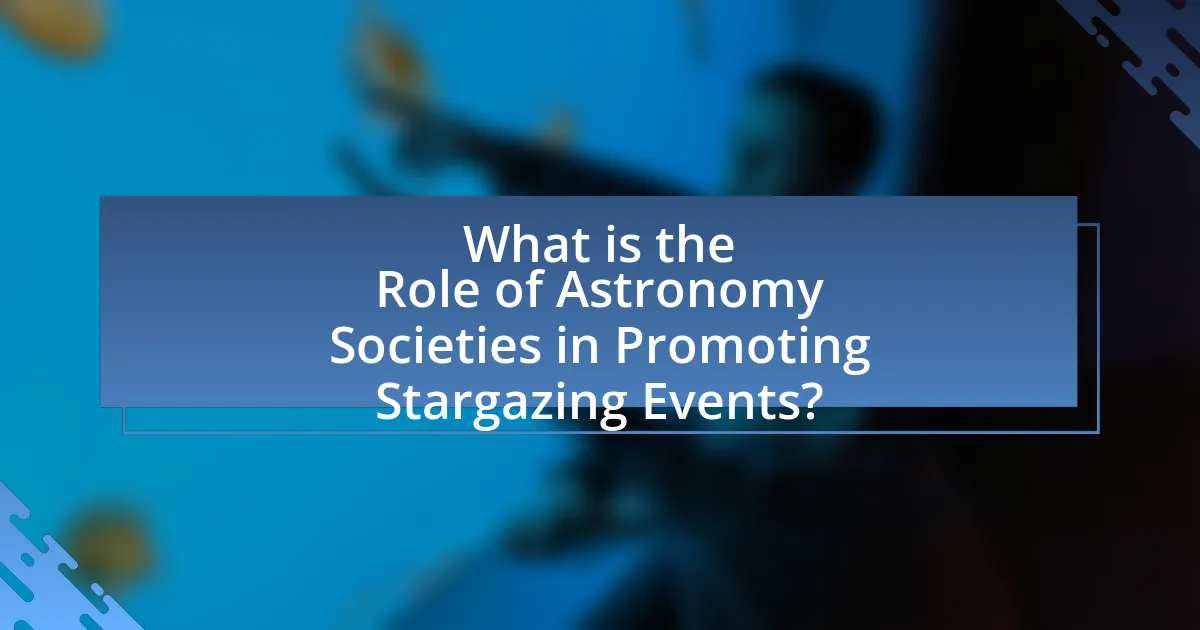
What is the Role of Astronomy Societies in Promoting Stargazing Events?
Astronomy societies play a crucial role in promoting stargazing events by organizing public outreach programs that enhance community engagement with astronomy. These societies often host events such as star parties, workshops, and lectures, which provide opportunities for individuals to learn about celestial phenomena and observe the night sky through telescopes. For example, the American Astronomical Society reports that local astronomy clubs frequently collaborate with schools and community centers to facilitate these events, thereby increasing public interest in astronomy and science education. Additionally, astronomy societies utilize social media and local advertising to reach a broader audience, ensuring that stargazing events are accessible to diverse populations.
How do astronomy societies contribute to public interest in stargazing?
Astronomy societies significantly enhance public interest in stargazing by organizing events, providing educational resources, and fostering community engagement. These societies host star parties, workshops, and lectures that allow individuals to observe celestial phenomena and learn about astronomy from experts. For instance, the Astronomical Society of the Pacific has been instrumental in promoting public outreach through its programs, which attract thousands of participants annually. Additionally, astronomy societies often collaborate with schools and local organizations to create accessible educational materials, further igniting curiosity and enthusiasm for stargazing among diverse audiences.
What initiatives do astronomy societies undertake to engage the community?
Astronomy societies engage the community through initiatives such as public stargazing events, educational workshops, and outreach programs. These societies organize events where community members can observe celestial objects using telescopes, fostering interest in astronomy. Educational workshops often cover topics like astrophysics and cosmology, providing participants with knowledge and skills related to the field. Outreach programs, including school visits and partnerships with local organizations, aim to inspire younger audiences and promote science literacy. For instance, the American Astronomical Society reports that such initiatives significantly increase public participation in astronomy-related activities, demonstrating their effectiveness in community engagement.
How do these initiatives impact local stargazing participation?
Initiatives by astronomy societies significantly increase local stargazing participation by providing organized events, educational resources, and community engagement. These societies often host public star parties, workshops, and lectures that attract diverse audiences, fostering interest in astronomy. For instance, a study by the American Astronomical Society found that communities with active astronomy clubs saw a 40% increase in public attendance at stargazing events compared to those without such initiatives. This engagement not only enhances knowledge but also builds a sense of community among participants, leading to sustained interest in stargazing activities.
Why are stargazing events important for astronomy societies?
Stargazing events are important for astronomy societies because they foster community engagement and enhance public interest in astronomy. These events provide opportunities for individuals to observe celestial phenomena, which can lead to increased membership and support for the society. Research indicates that hands-on experiences, such as stargazing, significantly improve public understanding of astronomical concepts and encourage lifelong learning in science. For example, a study by the American Astronomical Society found that participation in public outreach events, including stargazing, correlates with a 30% increase in interest in astronomy among attendees.
What educational benefits do stargazing events provide?
Stargazing events provide significant educational benefits by enhancing public understanding of astronomy and fostering scientific literacy. These events allow participants to observe celestial bodies, which helps to illustrate complex astronomical concepts such as planetary motion, star formation, and the scale of the universe. Research indicates that hands-on experiences, like those offered during stargazing, improve retention of scientific knowledge; for instance, a study published in the Journal of Astronomy & Earth Sciences Education found that interactive learning increases comprehension and interest in science topics. Additionally, stargazing events often include expert-led discussions, which further enrich participants’ knowledge and encourage critical thinking about the universe and our place within it.
How do stargazing events foster a sense of community among participants?
Stargazing events foster a sense of community among participants by providing a shared experience that encourages social interaction and collaboration. Participants gather to observe celestial phenomena, which creates opportunities for conversation and connection over a common interest in astronomy. Research indicates that such communal activities enhance social bonds; for instance, a study published in the Journal of Community Psychology found that shared experiences significantly increase feelings of belonging and community cohesion. Additionally, astronomy societies often facilitate group discussions and educational sessions during these events, further promoting engagement and collective learning among attendees.
What challenges do astronomy societies face in promoting stargazing events?
Astronomy societies face several challenges in promoting stargazing events, primarily including light pollution, weather conditions, and public interest. Light pollution significantly hampers visibility of celestial objects, making it difficult for participants to fully engage in stargazing. According to the International Dark-Sky Association, over 80% of the world’s population lives under light-polluted skies, which directly impacts attendance and enthusiasm for such events. Additionally, unpredictable weather can lead to cancellations or low turnout, as cloudy skies or rain deter potential attendees. Lastly, maintaining public interest is a challenge; many individuals may not prioritize stargazing due to competing activities or a lack of awareness about the benefits of astronomy. These factors collectively hinder the effectiveness of astronomy societies in successfully promoting and hosting stargazing events.
How do funding and resources affect the organization of stargazing events?
Funding and resources significantly influence the organization of stargazing events by determining the scale, accessibility, and quality of the experience offered. Adequate funding allows astronomy societies to secure high-quality telescopes, hire knowledgeable speakers, and provide educational materials, which enhance the overall experience for participants. For instance, a study by the American Astronomical Society found that events with higher budgets attracted more attendees and received better feedback due to improved facilities and resources. Additionally, resources such as partnerships with local schools or community centers can expand outreach efforts, making stargazing events more inclusive and accessible to diverse audiences.
What strategies can societies implement to overcome these challenges?
Societies can implement educational outreach programs to overcome challenges in promoting stargazing events. These programs can include workshops, school partnerships, and community events that raise awareness about astronomy and the importance of stargazing. For instance, the Astronomical Society of the Pacific has successfully engaged local communities through hands-on activities and public lectures, which have increased participation in stargazing events by over 30% in some regions. Additionally, societies can leverage social media and digital platforms to reach wider audiences, providing information on upcoming events and celestial phenomena, thus enhancing community engagement and interest in astronomy.
How do astronomy societies collaborate with other organizations for stargazing events?
Astronomy societies collaborate with other organizations for stargazing events by forming partnerships that enhance outreach and resource sharing. These collaborations often involve local schools, community centers, and science museums, which provide venues and promote events to a broader audience. For instance, astronomy societies may work with educational institutions to organize school field trips that include stargazing sessions, thereby engaging students in hands-on learning about astronomy. Additionally, partnerships with local parks or observatories can facilitate access to optimal viewing locations and specialized equipment. Such collaborations not only increase participation but also foster a sense of community and shared interest in astronomy, as evidenced by numerous successful joint events reported by various astronomy clubs across the United States.
What role does technology play in enhancing stargazing events?
Technology significantly enhances stargazing events by providing tools that improve visibility and accessibility of celestial observations. For instance, telescopes equipped with advanced optics allow for clearer and more detailed views of astronomical objects, while mobile apps like SkySafari and Star Walk enable users to identify stars and constellations in real-time, enhancing the educational experience. Additionally, live-streaming technology allows remote participation in stargazing events, making them accessible to a broader audience. According to a study published in the Journal of Astronomy Education, the integration of technology in stargazing events has been shown to increase participant engagement and knowledge retention by up to 30%.
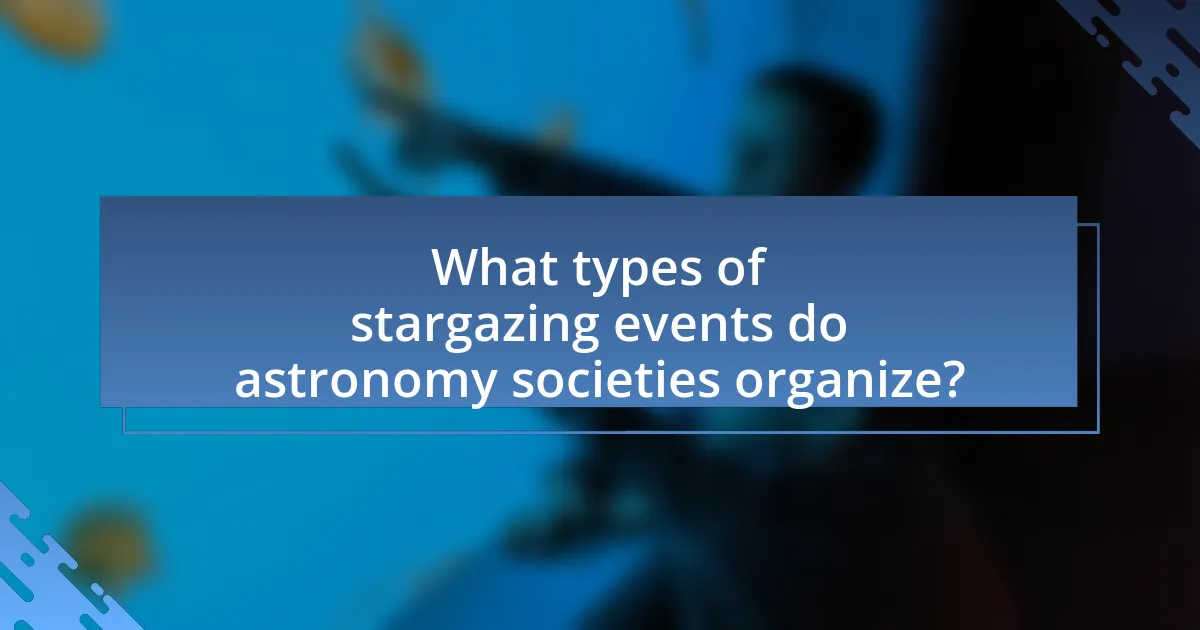
What types of stargazing events do astronomy societies organize?
Astronomy societies organize various types of stargazing events, including public star parties, educational workshops, and themed observation nights. Public star parties allow community members to observe celestial objects through telescopes, often featuring expert guidance from society members. Educational workshops focus on teaching participants about astronomy concepts and equipment usage, enhancing their stargazing experience. Themed observation nights may center around specific astronomical events, such as meteor showers or planetary alignments, providing targeted viewing opportunities. These events foster community engagement and promote interest in astronomy, as evidenced by the increased participation rates reported by societies during significant celestial events.
What are the different formats of stargazing events?
Different formats of stargazing events include public observation nights, workshops, guided tours, and themed events. Public observation nights typically involve telescopes set up for community use, allowing participants to view celestial objects with guidance from experienced astronomers. Workshops often focus on specific topics, such as astrophotography or telescope usage, providing hands-on learning experiences. Guided tours may include organized trips to dark sky locations, enhancing the stargazing experience with expert commentary. Themed events, such as meteor shower viewings or lunar observations, attract participants by focusing on specific astronomical phenomena. These formats are commonly organized by astronomy societies to engage the public and foster interest in astronomy.
How do public star parties differ from private viewings?
Public star parties are organized events open to the general public, while private viewings are exclusive gatherings typically limited to a select group of individuals. Public star parties often feature multiple telescopes, educational presentations, and opportunities for attendees to interact with amateur astronomers, fostering community engagement and education about astronomy. In contrast, private viewings usually focus on personalized experiences, where participants may have access to specific telescopes and tailored guidance from hosts, but lack the broader educational components and social atmosphere found in public events. This distinction highlights the role of astronomy societies in promoting accessibility and inclusivity in stargazing through public star parties.
What unique experiences do themed stargazing events offer?
Themed stargazing events offer immersive experiences that combine astronomy with specific themes, enhancing engagement and education. These events often include guided observations, where participants can learn about celestial objects related to the theme, such as mythology or seasonal changes. For instance, a Greek mythology-themed stargazing night may feature stories of constellations, allowing attendees to connect cultural narratives with the night sky. Additionally, themed events frequently incorporate interactive activities, such as workshops or discussions led by experts, which deepen participants’ understanding of astronomical concepts. This combination of storytelling, education, and hands-on experiences makes themed stargazing events unique and memorable.
How do astronomy societies tailor events for different audiences?
Astronomy societies tailor events for different audiences by customizing content, activities, and engagement strategies based on the audience’s age, knowledge level, and interests. For instance, they may offer family-friendly stargazing nights with hands-on activities for children, while organizing advanced lectures and discussions for seasoned astronomers. Additionally, societies often utilize surveys and feedback mechanisms to assess audience preferences, ensuring that events resonate with participants. This approach is supported by the fact that targeted programming increases attendance and satisfaction, as evidenced by a study from the American Astronomical Society, which found that tailored events can boost participation rates by up to 30%.
What considerations are made for families and children during stargazing events?
Stargazing events for families and children prioritize safety, accessibility, and educational engagement. Astronomy societies often ensure that locations are safe and well-lit, providing clear pathways and designated areas for families to gather. They also offer child-friendly activities, such as interactive exhibits and guided tours, to enhance learning and maintain interest among younger attendees. Additionally, many events include age-appropriate materials and resources, such as star charts and telescopes designed for children, to facilitate hands-on experiences. These considerations are essential for fostering a welcoming environment that encourages family participation in astronomy.
How do societies cater to experienced astronomers versus beginners?
Societies cater to experienced astronomers by providing advanced resources, specialized workshops, and opportunities for research collaboration, while they support beginners through introductory courses, public outreach programs, and accessible stargazing events. Experienced astronomers benefit from access to high-end telescopes, expert-led discussions, and networking opportunities with professionals in the field, which enhances their research and observational skills. In contrast, beginners are offered guided star parties, educational materials, and mentorship programs designed to foster interest and understanding of astronomy. This dual approach ensures that both groups receive tailored support, promoting engagement and knowledge sharing within the astronomical community.
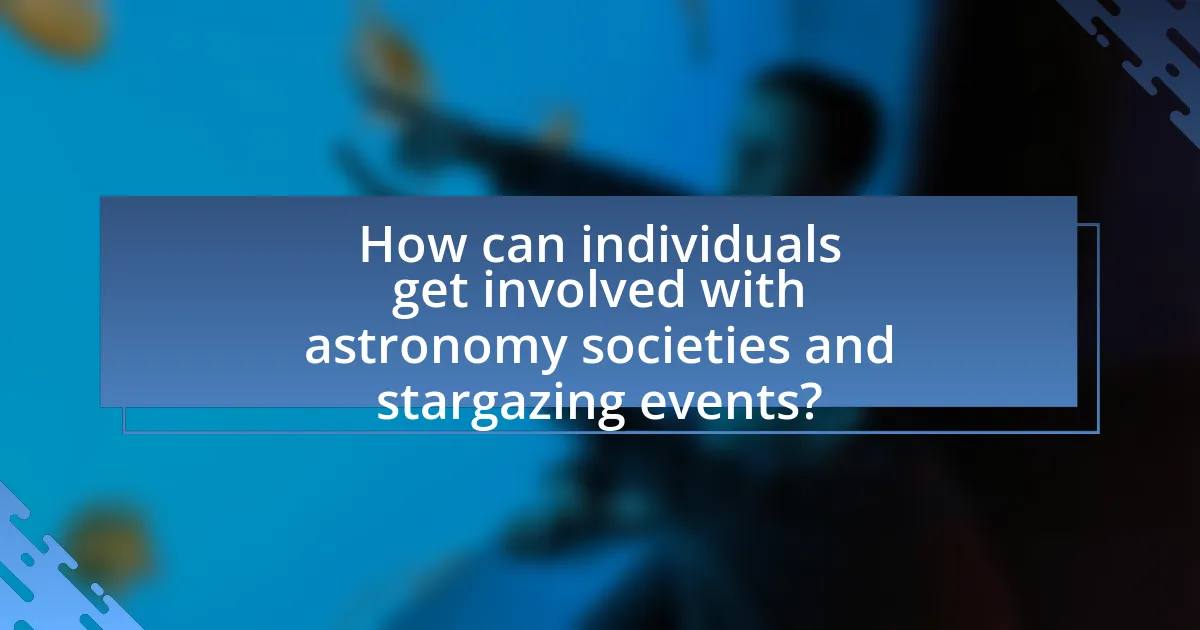
How can individuals get involved with astronomy societies and stargazing events?
Individuals can get involved with astronomy societies and stargazing events by joining local astronomy clubs or organizations that host regular meetings and public observing nights. Many societies offer membership options that provide access to resources, educational programs, and opportunities to participate in community outreach events. For instance, the American Astronomical Society lists numerous local chapters across the United States, which often organize stargazing events open to the public. Additionally, individuals can attend workshops, lectures, and star parties advertised on society websites or social media platforms, facilitating direct engagement with fellow astronomy enthusiasts and experts.
What are the benefits of joining an astronomy society?
Joining an astronomy society provides numerous benefits, including access to expert knowledge, networking opportunities, and participation in organized stargazing events. Members gain insights from experienced astronomers and enthusiasts, enhancing their understanding of celestial phenomena. Additionally, astronomy societies often host events such as star parties, lectures, and workshops, fostering community engagement and collaboration among members. Research indicates that participation in such societies can significantly increase individuals’ interest in astronomy and science, as evidenced by a study published in the Journal of Astronomy Education, which found that members reported higher levels of satisfaction and knowledge retention compared to non-members.
How does membership enhance personal knowledge and skills in astronomy?
Membership in astronomy societies enhances personal knowledge and skills in astronomy by providing access to educational resources, expert-led workshops, and collaborative learning opportunities. These societies often organize lectures, star parties, and hands-on activities that deepen understanding of celestial phenomena and observational techniques. For instance, members can participate in guided stargazing events where experienced astronomers share insights on identifying constellations and celestial objects, thereby improving observational skills. Additionally, many societies offer access to telescopes and other equipment, allowing members to gain practical experience in astronomical observation. This structured environment fosters a community of learning, where members can share knowledge and experiences, further enhancing their expertise in the field.
What networking opportunities are available through astronomy societies?
Astronomy societies provide various networking opportunities, including local chapter meetings, workshops, and conferences that facilitate connections among amateur and professional astronomers. These events often feature guest speakers, panel discussions, and collaborative projects, allowing members to share knowledge and experiences. For instance, the American Astronomical Society hosts annual meetings that attract thousands of participants, fostering professional relationships and collaborations in the field. Additionally, online forums and social media groups associated with these societies enable continuous interaction and support among members, enhancing community engagement and resource sharing.
What tips can individuals follow to maximize their stargazing experience?
To maximize their stargazing experience, individuals should choose a dark location away from city lights, as light pollution significantly hinders visibility of celestial objects. Research indicates that areas with a Bortle scale rating of 4 or lower provide optimal conditions for observing stars and planets. Additionally, using a star chart or stargazing app can help identify constellations and celestial events, enhancing the overall experience. It is also beneficial to allow the eyes to adjust to the darkness for about 20-30 minutes, which improves night vision and reveals fainter stars. Finally, bringing a comfortable chair or blanket can make the experience more enjoyable, allowing for longer observation periods.
How can one prepare for a successful stargazing event?
To prepare for a successful stargazing event, one should select a location with minimal light pollution, ideally away from urban areas. This ensures clearer visibility of celestial objects. Additionally, checking weather conditions is crucial; clear skies are essential for optimal stargazing. Bringing necessary equipment, such as telescopes or binoculars, enhances the experience by allowing detailed observation of planets and stars. Furthermore, having star charts or stargazing apps can help identify constellations and celestial events, enriching the overall experience. According to the International Dark-Sky Association, reducing light pollution significantly improves stargazing quality, making location choice vital for success.
What equipment is recommended for beginners in stargazing?
For beginners in stargazing, a good quality pair of binoculars and a simple star chart are recommended. Binoculars provide a wider field of view and are easier to handle than telescopes, making them ideal for newcomers. A star chart helps beginners identify constellations and celestial objects, enhancing their stargazing experience. These tools are accessible and affordable, allowing beginners to explore the night sky without significant investment.
